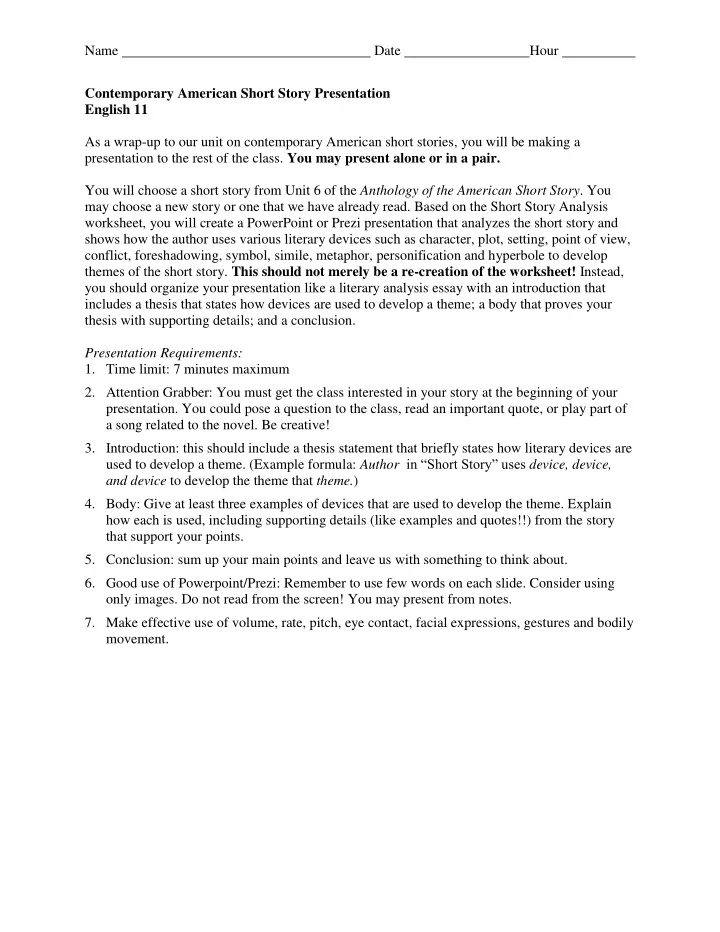

Name Date Hour Contemporary American Short Story Presentation English 11 As a wrap-up to our unit on contemporary American short stories, you will be making a presentation to the rest of the class. You may present alone or in a pair. You will choose a short story from Unit 6 of the Anthology of the American Short Story . You may choose a new story or one that we have already read. Based on the Short Story Analysis worksheet, you will create a PowerPoint or Prezi presentation that analyzes the short story and shows how the author uses various literary devices such as character, plot, setting, point of view, conflict, foreshadowing, symbol, simile, metaphor, personification and hyperbole to develop themes of the short story. This should not merely be a re-creation of the worksheet! Instead, you should organize your presentation like a literary analysis essay with an introduction that includes a thesis that states how devices are used to develop a theme; a body that proves your thesis with supporting details; and a conclusion. Presentation Requirements: 1. Time limit: 7 minutes maximum 2. Attention Grabber: You must get the class interested in your story at the beginning of your presentation. You could pose a question to the class, read an important quote, or play part of a song related to the novel. Be creative! 3. Introduction: this should include a thesis statement that briefly states how literary devices are used to develop a theme. (Example formula: Author in “Short Story” uses device, device, and device to develop the theme that theme. ) 4. Body: Give at least three examples of devices that are used to develop the theme. Explain how each is used, including supporting details (like examples and quotes!!) from the story that support your points. 5. Conclusion: sum up your main points and leave us with something to think about. 6. Good use of Powerpoint/Prezi: Remember to use few words on each slide. Consider using only images. Do not read from the screen! You may present from notes. 7. Make effective use of volume, rate, pitch, eye contact, facial expressions, gestures and bodily movement.
Name Date Hour Presentation Self-Evaluation Form The final grade for your exhibition will be a combination of: a. The grade you give yourself (and others in your group, if applicable) b. Your teacher’s grade for you Please complete the appropriate section ( not both ): Individual Evaluation 1. Quality of the final product .................................................... A B C D F 2. Overall effort you invested in project .................................... A B C D F Justify each grade in writing: Group Evaluation 1. Quality of the final product .................................................... A B C D F List yourself and other members in our group and grade each individual effort. State specifically what each contributed and justify the grade. a. (name) A B C D F b.(name) A B C D F
Name Date Hour Grading Rubric The score reflects the quality of the presentation as a whole - its content, style, and mechanics. Students are rewarded for what they do well. The score for an exceptionally well-crafted presentation may be raised by several points above the otherwise appropriate score. In no case may a poorly crafted presentation be scored higher than a D-. Score Description A These presentations offer a well-focused, persuasive analysis of how literary devices 90- are used to communicate a theme of the work, using apt and specific textual support. 100% Although they may not be error-free, these presentations make a strong case for their interpretation and discuss the literature with significant insight and understanding. In addition, these presentations make innovative use of the presentation format, engaging the audience with appropriate, relevant, thought-provoking imagery that is supported by language delivered with effective use of volume, rate, pitch, eye contact, facial expressions, gestures and bodily movement. B These presentations offer a reasonable analysis of how literary devices communicate a 80-89% theme. These responses have insight and understanding, but their analysis is less thorough, less perceptive, or less specific in supporting detail than that of the A presentations. In addition, their use of the presentation format is less innovative and less engaging, although it still uses quality, relevant, thought-provoking imagery that is supported by language delivered with effective use of volume, rate, pitch, eye contact, facial expressions, gestures and bodily movement. C These presentations respond to the task with a plausible reading, but tend to be 70-79% superficial or thinly developed in analysis. They often rely on plot summary that contains some analysis. Although these responses attempt to discuss how literary devices communicate a theme, they may demonstrate a rather simplistic understanding of story, and support from the text may be too general. These presentations demonstrate adequate control of language and the presentation format, but they may be marred by surface errors. These presentations are not as well planned, organized, developed, or delivered as B presentations. D These lower-half presentations fail to offer an adequate analysis of how literary 60-69% devices communicate a theme. The analysis may be partial, unsupported, or irrelevant, and the presentations may reflect an incomplete or oversimplified understanding of the story. They may not develop an analysis of the significance of the literary devices to the theme, or they may rely on plot summary alone. These presentations may be unfocused or repetitive, lack textual support, or contain many errors; they may lack control over the elements of good writing and good presentations. Presentations scored a D- may contain significant misreading and/or demonstrate inept writing or presentation skills. F Although these presentations make some attempt to respond to the prompt, they may 0-59% be unacceptably brief or incoherent in presenting their ideas. They may be poorly written and/or presented on several counts and contain distracting errors in grammar and mechanics. Remarks may be presented with little clarity, organization, or supporting evidence.
Recommend
More recommend